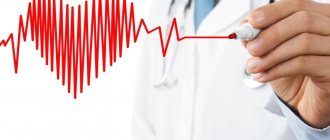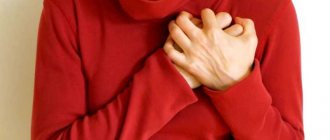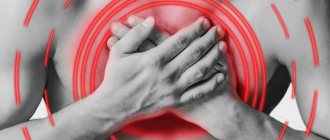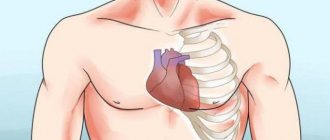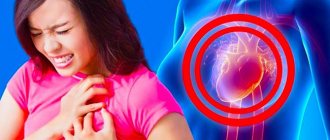Heart disease: 5 early signs
Heart Disease: 5 Early Signs
Many people first think about their heart only after a heart attack, although paying close attention to alarming heart symptoms could keep them healthy.
shortness of breath, myocardial infarction, arrhythmia, edema, diagnosis
According to statistics, diseases of the cardiovascular system rank first among the causes of death among the adult population of Russia and the whole world. The most susceptible to heart disease are men over 30–40 years of age and women over 60 (at the onset of menopause). Sudden death, which is associated with coronary pathology (impaired blood supply to the heart), has become especially important in recent years.
However, only rare forms of cardiovascular diseases are asymptomatic. In most cases, the body begins to give alarm signals long before the disaster. The main thing is to recognize them in time and take the necessary measures.
Chest pain cannot be tolerated. If you experience unpleasant sensations in your heart, you should stop and, if possible, sit down or lie down. People suffering from coronary heart disease should always have fast-acting nitroglycerin preparations with them and take a dose of the medicine when pain occurs.
Why is the heart often found in sayings?
Since this organ is one of the vital organs in our body, it is not surprising that this word is often used in various phraseological units. In essence, the phrase “heart skipped a beat” means that a person has an arrhythmia due to fear or anxiety.
The word heart can also be found in other phraseological units, for example: “You can’t order your heart” - when the choice is made not by the mind, but by the soul. “The heart does not lie” - with approximately the same meaning about choosing not by reason, but by the sixth sense. “Out of sight, out of mind” - the desire to forget and never see. “Reluctantly” - doing something against your will. “In the hearts” - to do something spontaneously, at the first desire, without thinking it through.
Symptoms of freezing and diagnosis
Any malfunction of the heart requires qualified diagnosis. There are often cases when a person complaining of bradycardia received advice... to lie down and relax, to lie down and rest.
The result was an even greater decrease in heart rate, which required the professional intervention of resuscitators. The examination begins with the simplest methods: counting the number of heartbeats with determination of rhythm, measuring blood pressure, and examining the skin.
The main method for diagnosing cardiac arrhythmias is ECG.
Sometimes, to clarify the group arrhythmia, 24-hour monitoring of cardiac activity and an esophageal ECG are performed. Depending on the type of arrhythmia, treatment is prescribed, which can be aimed at the cause of the arrhythmia (as in the case, for example, arrhythmia due to medication), and at reducing the frequency of attacks, if the underlying cause cannot be cured.
Treatment can be conservative - with the use of appropriate medications, or surgical - the introduction of a pacemaker or other pacemakers.
I'm worried about the feeling of my heart tumbling - what to do?
Diseases of the heart and vascular system are becoming increasingly common. Moreover, not only elderly and middle-aged people encounter them, but also young people. The feeling of your heart tumbling is a symptom that more and more people are complaining about. If you visit several forums dedicated to pathologies of the heart muscle, you will come across this concept more than once.
Extrasystole - what is it?
This is a representative of the most common heart diseases. The term reflects heart rhythm disturbances when contraction occurs much earlier than that of a healthy muscle. This disease is easy to identify; if there are complaints about the heart tumbling, the patient is sent to an ECG, which shows a premature or rapid rhythm.
Ideally, such a heart problem can be detected even in a healthy person, which means that such a disorder does not require emergency treatment. However, there is a certain norm when the number of extrasystoles is not life-threatening - no more than 200. If it is less, then there is nothing to worry about, and the person is absolutely healthy, because like any other organ, the heart cannot work 100% perfectly.
When a person experiences extrasystole more often and notices some symptoms of tachycardia, this is a reason for an early examination by a doctor. Because behind these symptoms there may be more serious ones that can lead to irreversible consequences.
It is necessary to combat extrasystole in the following cases:
- hemodynamic disorders caused by nervous heart rhythm;
- personal feelings of a person when he realizes that the frequency and evenness of the heartbeat is no longer the same and begins to cause discomfort;
- if during the examination the doctor detects a deterioration in myocardial performance, which in no case should be left without medical intervention.
Localization area
This is a rather interesting disease from a medical point of view, because it has several types of location in the heart muscle. Supraventricular is the result of arrhythmia, which is caused by foci of impulses in the heart muscle.
They are usually located in the atrioventricular septum or supraventricular region. If a person encounters ventricular localization, it occurs due to the formation in the ventricles of the muscle of an absolutely independent source of contraction of impulses, which interferes with the stable functioning of the heart.
This problem is more often encountered by older men.
In fact, the symptoms themselves are not pronounced, but as with other arrhythmic disturbances, there is a feeling of the heart tumbling, freezing or increased rhythm. This form of localization does not pose a threat to life, however, if the indicators are elevated, examination and treatment are necessary.
Atrial appears as a result of the occurrence of foci of electrical impulses in the atria. Atrioventricular is the result of the formation of a focus of pathology in the area of the ventricular-atrial septum.
Causes
Extrasystole is a disease, the causes of which are very similar to those that characterize other cardiac pathologies. Among them:
Symptoms
As mentioned earlier, the symptoms of the disease are very similar to other diseases of the heart muscle. Among them:
- weakness and dizziness;
- fear and anxiety;
- insomnia;
- increased sweating;
- arrhythmia that the patient himself feels: the heart beats faster or, on the contrary, freezes;
- feeling of heart tumbling.
Diagnostics
The easiest way to identify the disease is with an electrocardiogram. This type of study guarantees an accurate and easy calculation of the malfunction of the heart muscle, because all abnormal, normal and rapid contractions appear on the tape.
However, it is not always possible to detect extrasystoles using a cardiogram, because the procedure for obtaining a “snapshot of the heart’s work” lasts a short time and it is during this period that the heart can work like a clock. All this is due to the fact that during the ECG the patient is in a supine position, i.e. does not show activity, but in life the person is usually active.
If extrasystole cannot be detected by this method, the patient is prescribed a Holter mount. This method involves monitoring the patient throughout the day, which should take place in his usual way. It is in this way that the doctor will be able to determine the absence or presence of disruptions in the rhythm of muscle work.
Treatment methods
It sounds strange, but such a problem is sometimes treated with just a regular visit to a psychologist or psychiatrist. The essence of the technique is to remove the patient from a depressive or anxious state, which adversely affects the functioning of the heart.
In practice, drug treatment is also carried out. To do this, you will need to see a cardiologist who will prescribe medications:
- to maintain normal production of adrenaline in the blood;
- used for arrhythmia;
- replenishing calcium levels in the body.
And, as always, do not forget about the folk recipe. It is often prescribed by doctors. For example, to treat extrasystole of the heart muscle, you can use the following recipes:
- Make a hawthorn tincture. To do this, you need to fill the hawthorn with water and leave for 10 days. Take the resulting mixture three times a day, 10 drops.
- Valerian tincture is used in a similar way. To prepare it, pour a few teaspoons of the plant with boiling water in a volume of 100 ml and cook for 10 minutes.
If the heart seems to be tumbling and all of the above treatment methods are ineffective, doctors resort to surgery. To do this, a special catheter is taken, with the help of which special impulses are sent by radio frequencies, necessary for the correct heart rhythm.
ontakteWhatsApp in Symptoms
Source: //vserdtse.com/chuvstvo-kuvyrkanija-serdca.html
What is extrasystole?
Extrasystole is an untimely contraction of the myocardium or its individual sections. This is one of the most common types of arrhythmias. In addition to heart disease, the appearance of extrasystole can be provoked by:
• bad habits (tobacco smoking, alcoholism);
• increased physical activity;
• abuse of caffeinated drinks.
Predisposing factors that can lead to extrasystole are:
• VSD (vegetative-vascular dystonia).
Often, extrasystole is discovered accidentally during an ECG and is not accompanied by any symptoms.
Causes of cardiac arrest
Among the causes, one can distinguish directly cardiac (cardiac) and external (extracardiac).
The main cardiac factors are:
- myocardial ischemia and inflammation;
- acute obstruction of the pulmonary vessels due to thrombosis or embolism;
- cardiomyopathy;
- high blood pressure;
- atherosclerotic cardiosclerosis;
- rhythm and conduction disturbances due to defects;
- development with hydropericardium.
Extracardiac factors include:
- oxygen deficiency (hypoxia) caused by anemia, asphyxia (suffocation, drowning);
- pneumothorax (the appearance of air between the layers of the pleura, unilateral compression of the lung);
- loss of a significant volume of fluid (hypovolemia) due to injury, shock, persistent vomiting and diarrhea;
- metabolic changes with a deviation towards acidosis;
- hypothermia (hypothermia) below 28 degrees;
- acute hypercalcemia;
- severe allergic reactions.
Pneumothorax of the right lung sharply shifts the heart to the left, with a high risk of asystole
Indirect factors that influence the stability of the body’s defenses are important:
- excessive physical stress on the heart;
- elderly age;
- smoking and alcoholism;
- genetic predisposition to rhythm disturbances, changes in electrolyte composition;
- suffered electrical trauma.
A combination of factors significantly increases the risk of cardiac arrest. For example, drinking alcohol in patients with myocardial infarction causes asystole in almost 1/3 of patients.
Causes
In children and adolescents, respiratory arrhythmia, as a rule, does not cause any discomfort and is detected only during routine examinations. Pathology, as a rule, appears only with deep breathing; when inhaling, the rhythm becomes more frequent, and when exhaling, on the contrary, it slows down.
In adult patients, this condition is much less common. It is most often due to the following reasons:
- increased nervousness, stress;
- past illnesses;
- smoking;
- taking certain medications.
There are no specific symptoms for this condition; moreover, most often a person simply does not notice that there is something wrong with him. When respiratory arrhythmia is detected in young people and children, no special measures need to be taken. This condition is considered normal and goes away on its own with age.
Advice! However, if the doctor, having discovered signs of heart rhythm disturbances in children, considers it necessary to refer the child for additional examination, you should not object. The fact is that this condition may be a sign that not everything is in order in the body.
What pathologies can it warn about?
The identified symptoms of respiratory arrhythmia can be either signs of the development of a disease, or, on the contrary, mean that the patient’s condition is improving. Here are some interesting facts:
- if symptoms of rhythm disturbances associated with breathing appeared after infectious myocarditis in children or a heart attack in adults, this indicates that the patient is recovering;
- sometimes the disappearance of respiratory arrhythmia indicates that the patient is developing one or another cardiac pathology. For example, in case of problems with blood vessels, the development of heart disease, etc.
Advice! Most often, in children of different ages, the appearance of respiratory arrhythmia is in no way associated with deterioration in health. But the appearance of a similar condition in adults can warn of the development of disturbances in the functioning of the heart.
